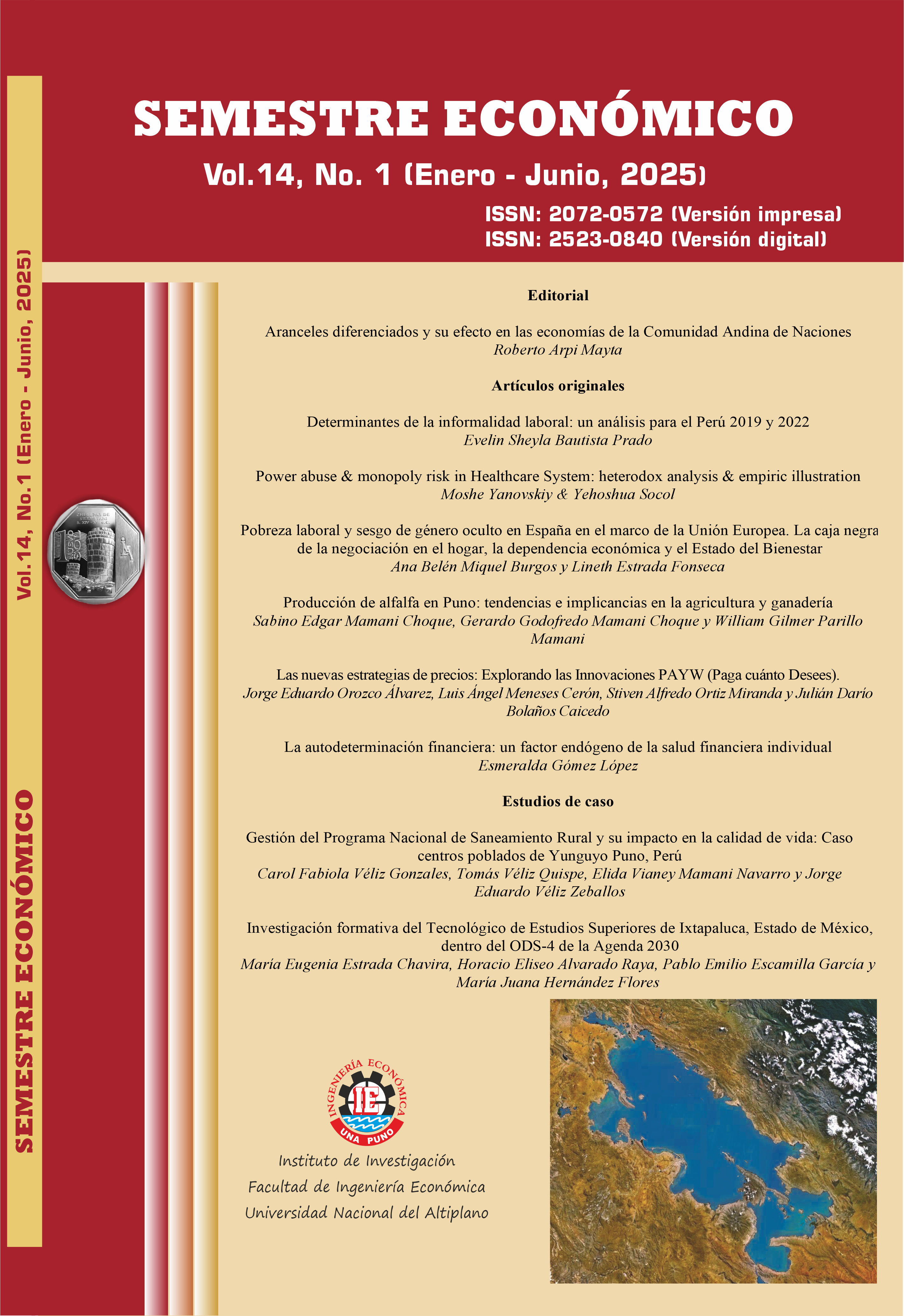Las nuevas estrategias de precios: Explorando las Innovaciones PAYW (Paga cuánto Desees).
DOI:
https://doi.org/10.26867/se.2025.v14i1.182Palabras clave:
Estrategias de precios, Nuevos enfoques, Innovaciones PAYW, Pago como Desees, Explorando dinámicas de precios.Resumen
Este artículo de investigación examina el impacto y la aplicabilidad de las estrategias de precios innovadoras en el mercado actual. Con un enfoque particular en las innovaciones PAYW (Paga Cuánto Desees), se explora cómo este modelo de fijación de precios desafía los enfoques tradicionales. Se investigó cómo el modelo de Pago Cuánto Desees está siendo adoptado por diversas empresas en diferentes sectores, evaluando sus ventajas y desafíos. También, se analiza cómo esta estrategia puede influir en la percepción del valor del consumidor y en las relaciones con los clientes. A través de un análisis profundo de las dinámicas de precios y casos de estudio relevantes en empresas globales, se busca proporcionar una comprensión integral de la efectividad y el potencial de las innovaciones PAYW en la configuración de las estrategias comerciales futuras. Se identificó que la implementación de PAYW plantea un desafío estratégico para las empresas: cómo empoderar a los clientes mientras se mantiene la rentabilidad a través del tiempo.
Métricas
Referencias
Akbari, K., & Wagner, U. (2022). Erratum on the Pay-as-You-Wish model by Chen et al. (2017). Mar-keting Science, 41(3), 657. https://doi.org/10.1287/mksc.2021.1319
Ariely, D., Gneezy, U., & Haruvy, E. (2005). The Effect of Relative Thinking on the Perceived Price of a Coat Check. Marketing Science, 24(1), 151-157.
Chen, et al. (2017). The Role of Money Illusion in Pay-What-You-Want Pricing. Journal of Marketing Research, 54(6), 931-945.
Chen, Z., & Liang, X. (2014). The performance of pay-as-you-wish pricing with relational and forward-l ooking customers. 11th International Conference on Service Systems and Service Management, 1-5. https://doi.org/10.1109/ICSSSM.2014.6943418
Groening, C., & Mills, P. (2017). A guide to pay-what-you-wish pricing from the consumer’s viewpoint. Business Horizons, 60(4), 441-445. https://doi.org/10.1016/j.bushor.2017.03.004
HBS, W. (2015). Pay What You Wish: What Happens When Customers Choose The Price. Forbes. https://www.forbes.com/sites/hbsworkingknowledge/2015/07/22/pay-whatever-you-want-when-retailers-let-customers-name-their-price/
Hou, H., Wu, F., & Kong, X. (2023). Optimal pricing strategy for content products under competition: Pay-as-you-want or fixed-price? Computers & Industrial Engineering, 181, 109298. https://doi.org/10.1016/j.cie.2023.109298
Just, N. (2018). Governing online platforms: Competition policy in times of platformization. Tele-communications Policy, 42(5), 386-394. https://doi.org/10.1016/j.telpol.2018.02.006
Kim, J. H., Natter, M., & Spann, M. (2009). Pay What You Want: A New Participative Pricing Mecha-nism. Journal of Marketing, 73(1), 44-58.
Kotler, P. y Armstrong, G. (2018). Principios de marketing (17.ª ed.). The University of Minnesota Li-braries Publishing.
https://open.lib.umn.edu/principlesmarketing/
Kotler, P., & Keller, K. L. (2016). Marketing Management (15th ed.). Pearson.
Lin, Q., & Lu, A. (2022). The magic of lottery: Investigating the PAYW in live streaming from oppor-tunism and impulsiveness. ICIS 2022 Proceedings, (10). https://aisel.aisnet.org/icis2022/digital_commerce/digital_commerce/10
Malhotra, N. K., Huang, M. H., & Mishra, A. (2005). The Relative Influence of Explanations on Con-sumers’ Willingness to Pay: A Comparison of Alternative Pay-What-You-Want Approaches. Journal of Consumer Research, 32(4), 567-575.
Malhotra, N. K., Huang, M. H., & Mishra, A. (2005). The Relative Influence of Explanations on Con-sumers’ Willingness to Pay: A Comparison of Alternative Pay-What-You-Want Approaches. Journal of Consumer Research, 32(4), 567-575.
Meneses Cerón, L. Ángel y Shirley Rueda, L. 2018. Diseño de un sistema piloto de costeo ABC como herramienta para la toma de decisiones en una empresa de servicios, el caso de la agencia Ecoturismo Putumayo. Apuntes Contables. 22 (nov. 2018), 101–122. https://doi.org/10.18601/16577175.n22.07
Meneses Cerón, L. Á., van Klyton, A., Rojas, A., & Muñoz, J. (2024). Climate Risk and Its Impact on the Cost of Capital—A Systematic Literature Review. Sustainability, 16(23), 10727. https://doi.org/10.3390/su162310727
Monroe, K.B. (2003) Pricing-Making Profitable Decisions. 3rd Edition, McGraw Hill/Irwin, New York.
Scheibehenne, B., & Sturm, N. (2015). Pay what you want, self-image and identity: Insights from an experiment on own- and other-image effects. Journal of Behavioral and Experimental Economics, 56, 1-8.
Williams, K. R. (2022). The welfare effects of dynamic pricing: Evidence from airline markets. Econ-ometrica, 90(3), 1265–1302. https://doi.org/10.3982/ECTA16180
Ziari, M., & Sajadieh, M. S. (2021). A behavior-based pricing model in retail systems considering ver-tical and horizontal competition. Computers & Industrial Engineering, 152, 107054. https://doi.org/10.1016/j.cie.2020.107054
















